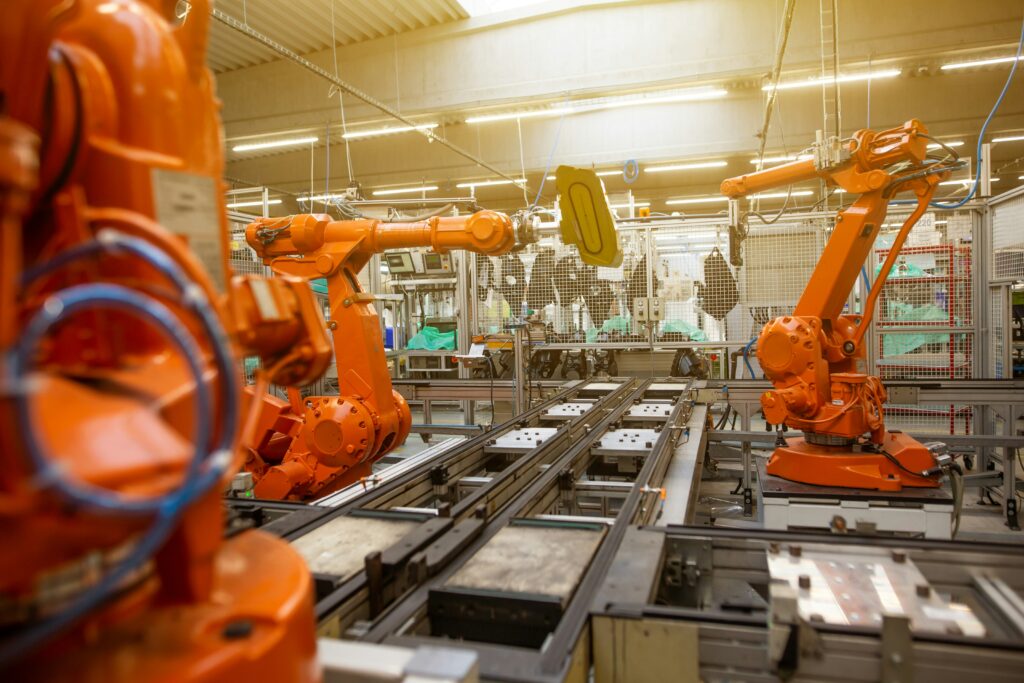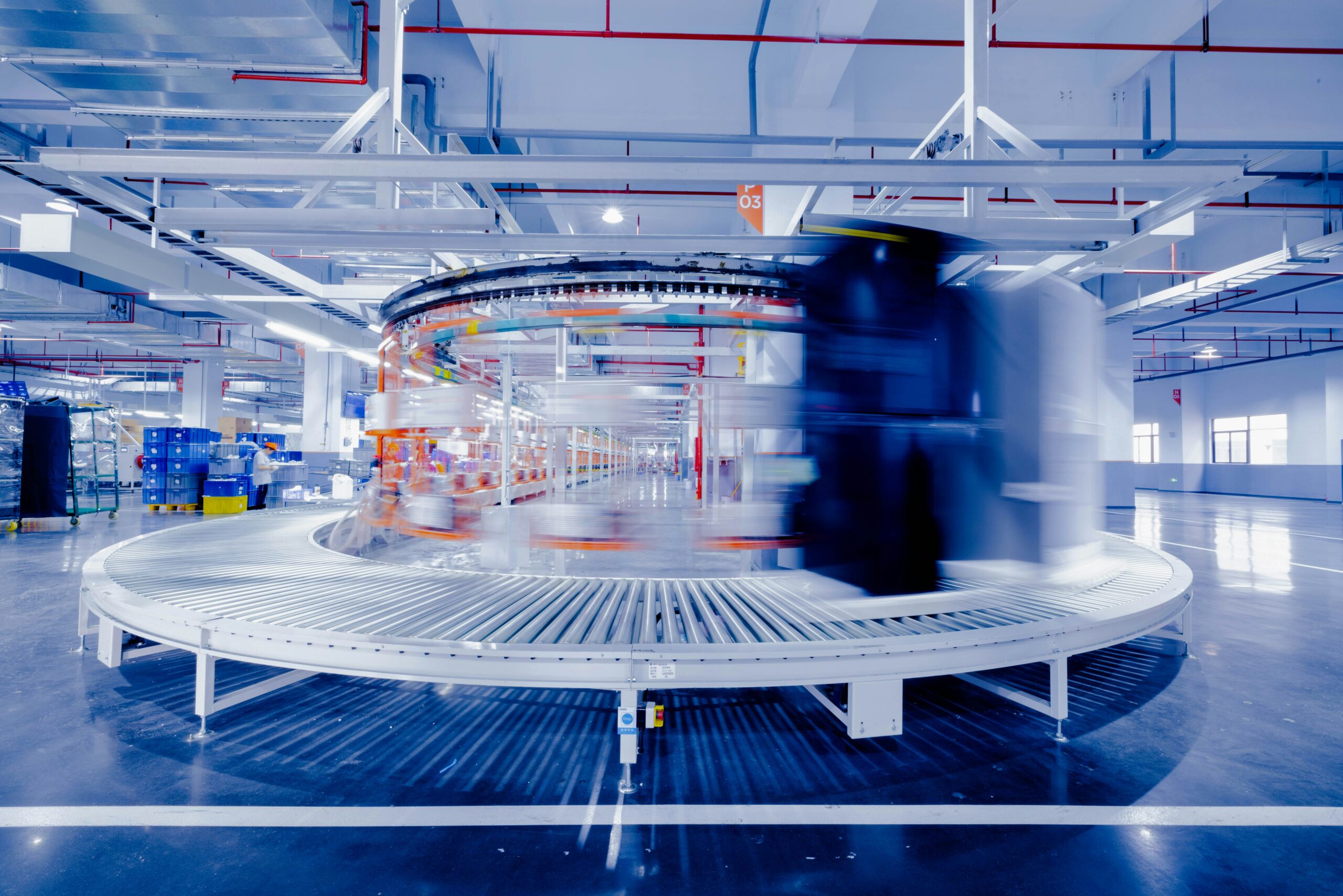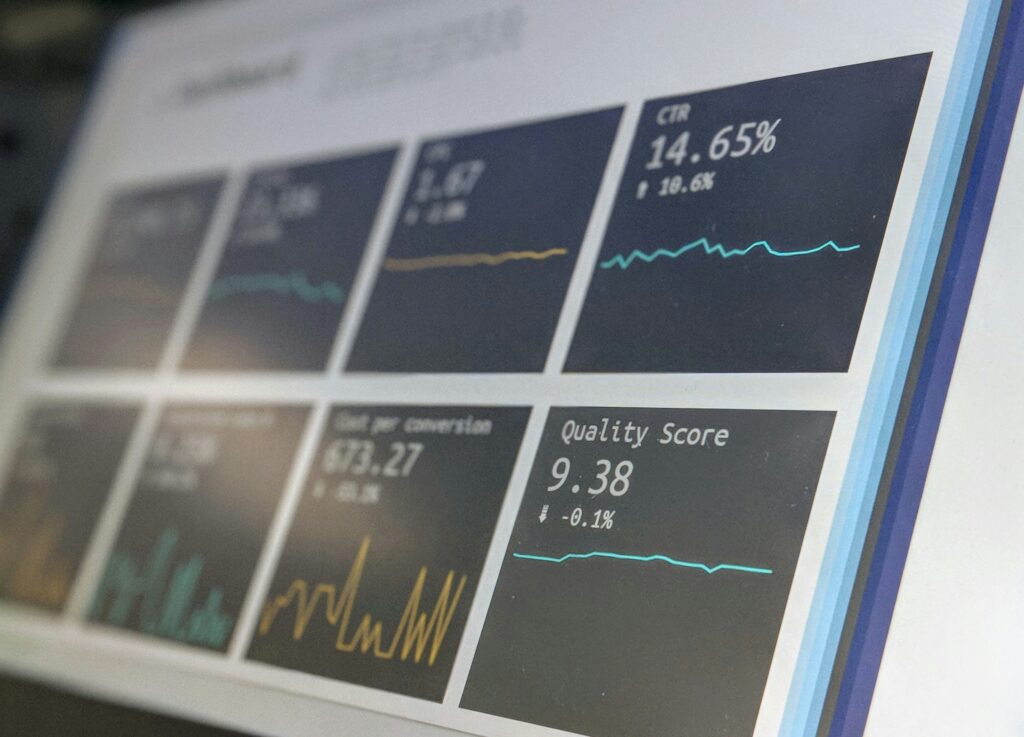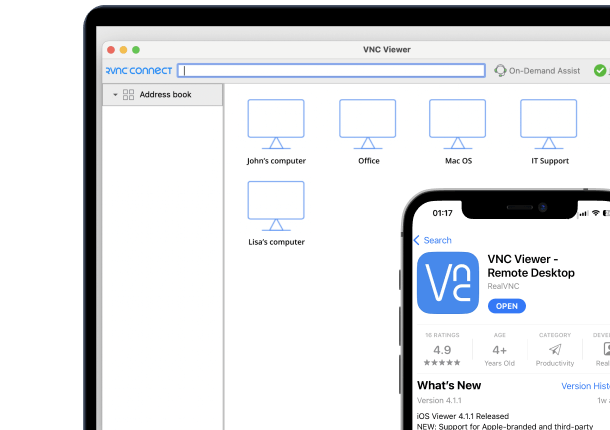Digital transformation in manufacturing involves more than just upgrading your tech stack; it’s a comprehensive strategy that can boost throughput by up to 30% and reduce machine downtime significantly for many manufacturers.
With global digital transformation spending expected to soar past $3.4 trillion by 2027, staying ahead means integrating IoT, automation, and analytics. Let’s look at what else you need to know about this fascinating era in technology and its digital applications in manufacturing.
What is Digital Transformation in Manufacturing?

Implementing digital transformation in a way that benefits manufacturing involves integrating advanced digital tech-such as the Internet of Things (IoT), automation, analytics, and cloud computing-into factory operations. This integration is crucial for driving production optimization and achieving competitive differentiation.
By embracing these technologies, manufacturers can experience increased throughput by 10% to 30%, reduce machine downtime by as much as 50%, and improve the cost of quality by 10% to 20%. Additionally, digital transformation can improve forecasting accuracy for manufacturers by 85%, enabling better demand planning and resource allocation, and energy consumption reductions, reducing costs.
Despite these benefits, only one-third of manufacturers have moved beyond the initial planning stages of your digital transformation strategy. This highlights a significant opportunity for growth and improvement within the industry. With IDC predicting global digital transformation spending to surpass $3.4 trillion by 2027, the urgency for manufacturers to adopt these technologies becomes evident.
Digital transformation involves everything from the deployment of smart sensors that capture live data to the utilization of cloud-based systems that enable seamless access to information across global operations. These innovations not only streamline production processes but also enhance decision-making capabilities by providing actionable insights based on live data collection. Using AI technology also has the potential to create safer working environments, resulting in fewer workplace injuries.
Manufacturers can ensure they remain competitive and responsive to ever-changing market demands with a well defined digital transformation strategy. It can enhance collaboration across organizations, increasing overall efficiency and streamlining operations.
Key Components Driving Digital Transformation in Manufacturing

Digital transformation revolutionizes manufacturing through several key components: IoT sensors capture real-time production data for optimized operations and support industrial automation; advanced analytics deliver up to 85% improved forecasting accuracy for better demand planning and quality control by transforming raw data into actionable insights; and AI-enhanced manufacturing streamlines operations with schedulers that reduce downtime, minimize bottlenecks, and optimize assembly line balance-all directly improving overall throughput and efficiency.
Digital twins enable virtual simulations for process optimization without disrupting operations, forming a cornerstone of smart factory implementation, ideal for any large scale manufacturing business. Digital forms and cloud-based ERP systems replace paper-based methods, enhancing data accessibility and enabling real-time decision-making across global teams.
Maintenance prediction strategies, powered by real-time analytics, increase productive time by 10-20% through forecasting equipment failures and scheduling timely interventions, extending asset lifespan and ensuring continuous manufacturing efficiency improvements.
Digital Technologies in Manufacturing
Technology continues to advance manufacturing company processes by improving efficiency, reducing costs, and enhancing product quality. The adoption of digital advancements like Industrial IoT, smart manufacturing, and digital twins is transforming traditional manufacturing methods. These innovations enable manufacturers to streamline operations, make data-driven decisions, and stay competitive in a rapidly evolving market.
Incorporating digital services into manufacturing allows for real-time data monitoring and analysis, which is crucial for optimizing manufacturing lines and ensuring consistent product quality. By leveraging these technologies, manufacturers can identify inefficiencies, predict maintenance needs, and respond swiftly to market demands. This shift from traditional manufacturing methods to a more connected and intelligent approach is driving significant improvements in productivity and operational agility.
Industrial IoT and Automation
Industrial IoT (IIoT) and automation are key technologies that are transforming the manufacturing industry. IIoT involves the use of sensors, smart devices, and technologies such as RFID, Bluetooth, and WiFi to collect data on machine performance, production quality, inventory levels, and supply chain management. This live data monitoring enables manufacturers to monitor and optimize their operations continuously.
Automation technologies, including robotic process automation (RPA) and machine learning (ML), are being used to automate tedious processes, improve quality control, and enhance predictive maintenance. For instance, RPA can handle repetitive tasks such as data entry and inventory management, freeing up human workers to focus on more complex and value-added activities. ML algorithms can analyze vast amounts of data to predict equipment failures and schedule maintenance before issues arise, reducing maintenance costs and extending the lifespan of machinery.
By integrating IIoT and automation, manufacturers can achieve higher levels of efficiency and precision, ultimately leading to better product quality and reducing costs. These technologies are essential for modernizing manufacturing techniques and staying competitive in a digital-first world.
Smart Manufacturing and Digital Twins
Smart manufacturing involves the use of advanced technology like artificial intelligence (AI), machine learning (ML), and digital twins to improve manufacturing. Digital twins are virtual replicas of physical products or systems that can be used to simulate and optimize manufacturing processes. By creating a digital twin of a manufacturing line, companies can test different scenarios and identify the most efficient workflows without disrupting actual operations.
Artificial intelligence and ML play a crucial role in smart manufacturing by enabling predictive analytics and real-time decision-making. These technologies can analyze data from various sources to identify patterns and trends, allowing manufacturers to anticipate market demands and adjust production accordingly. This level of insight helps in creating products that are tailored to specific customer needs, improving product quality, and reducing production costs.
Smart manufacturing and digital twins represent a significant leap forward from traditional manufacturing processes. They provide manufacturers with the tools to innovate continuously, enhance operational efficiency, and deliver high-quality products that meet the evolving needs of customers.
Benefits and ROI of Digital Transformation in Manufacturing

Digital transformation in manufacturing offers robust financial and operational advantages, driving significant improvements in production efficiency and cost-effectiveness. By implementing technology-driven production optimization, manufacturers can achieve throughput enhancements ranging from 10% to 30%. This heightened efficiency not only increases overall output but also optimizes resource utilization across manufacturing company operations.
Labor productivity sees a substantial boost, with increases ranging from 15% to 30%. This is largely due to the integration of automation investments and real-time production monitoring systems that streamline operations and reduce manual intervention. Advanced manufacturing analytics further enhance quality monitoring measures, ensuring consistent product standards and reducing the likelihood of costly errors or rework.
Digital transformations can reduce production costs by up to 70% through automation and process optimization, while improving On-Time In-Full scores by approximately 10 percentage points—critical for maintaining competitive advantage in supply chain integration. Environmental benefits include average reductions of 15% in both CO2 emissions and water consumption through operations that prioritize sustainability alongside productivity.
Real-World Examples and Case Studies of Digital Transformation in Manufacturing

Digital transformation and how it relates to manufacturing is exemplified by several compelling success stories that showcase how manufacturing companies strategically adopt advanced technologies. These examples highlight the tangible benefits realized through implementing machine learning applications, predictive maintenance solutions, and digital twin technology.
A global reinforcement provider for digital solutions operating across seven countries leveraged remote monitoring software and digital twin simulations to enhance its operations. By integrating these technologies, the company achieved seamless cross-border coordination and improved assembly line efficiency.
A pharmaceutical company reduced downtime by 30% using predictive maintenance and IoT sensors, while a food producer cut production costs by 20% through AI scheduling. Another pharmaceutical manufacturer decreased changeover time by 40% by implementing cloud-based ERP systems, improving operational agility.
These success stories illustrate how incorporating new technologies can radically transform manufacturing company processes. By adopting advanced digital tools, these companies have not only improved their operational efficiency but also set new benchmarks for quality and productivity. The strategic implementation of these technologies serves as a testament to the power of digital transformation in driving industry innovation and competitiveness.
How RealVNC Connect Supports Digital Transformation in Manufacturing
RealVNC Connect stands out as a leading solution for enterprise connectivity, driving digital transformation for manufacturing through secure and versatile remote access capabilities. With 256-bit AES encryption, it ensures that industrial operations remain uninterrupted and secure, safeguarding sensitive production data across all platforms-Windows, macOS, Linux, and even Raspberry Pi.
Manufacturing leaders recognize the importance of digital transformation for enhancing efficiency and competitiveness, underscoring the necessity of aligning digital strategies with critical business outcomes to maximize business value and adapt to market challenges.
Key features of RealVNC Connect include robust screen recording functionalities, pivotal for compliance and IT troubleshooting. This feature allows manufacturers to document processes, support regulatory audits, and streamline employee training by capturing detailed workflows.
It allows for real-time oversight through remote access, of manufacturing company assets, enabling rapid identification and resolution of technical issues. This feature supports IT teams in maintaining operational continuity, even in the most complex hybrid manufacturing environments.
In a competitive industry where efficiency and cybersecurity are paramount, RealVNC Connect delivers unparalleled support for digital transformation initiatives. Its cross-platform compatibility and advanced security measures make it an ideal choice for manufacturers seeking to enhance operational resilience and productivity. By integrating RealVNC Connect into their digital strategies, manufacturers can effectively modernize their IT infrastructure, optimize resource maanagement, and maintain a competitive edge in today’s fast-evolving industrial landscape.
Challenges and Solutions in Digital Transformation in Manufacturing
Manufacturers embarking on digital transformation face several hurdles, chief among them being the integration of new digital tools with existing legacy systems. This often results in compatibility issues that can disrupt workflows. To tackle these system integration challenges and enhance the manufacturing process, companies can leverage secure remote access solutions like RealVNC Connect, which facilitate seamless connectivity across diverse platforms without compromising data integrity.
Key digital transformation challenges include integrating new tools with legacy systems, which can cause compatibility issues and workflow disruptions. Effective change management requires deliberate strategies for employee buy-in through clear communication and training. A phased approach to upgrading legacy systems allows manufacturers to gradually implement advanced solutions while minimizing operational disruptions and aligning with strategic goals.
Regulatory compliance for smart systems is another critical consideration. Manufacturers must ensure that their digital transformation initiatives adhere to industry regulations, which can be a complex task. Partnering with technology vendors who understand these compliance requirements can simplify this process, ensuring that all digital tools meet necessary standards.
Cybersecurity protocols in production are paramount, given the increased connectivity and data exchange inherent in digital transformation. Implementing robust security measures, such as zero-trust architectures and encrypted communications, protects against threats and maintains operational integrity. By focusing on these actionable solutions, manufacturers can overcome the challenges of digital transformation, driving innovation and maintaining a competitive edge.
Managing Change and Employee Buy-in
Managing change and securing employee buy-in are critical to the success of digital adoption in manufacturing. A well-defined strategy that aligns with business goals is essential for guiding this transition. Communicating the benefits of these processes to employees helps in gaining their support and ensuring a smooth implementation of new technologies.
Employee buy-in is crucial for the successful adoption of new technologies and processes. Manufacturers can achieve this by providing comprehensive training and development programs that equip employees with the necessary skills to operate advanced technologies effectively. Encouraging employee feedback and involving them in the transformation process fosters a sense of ownership and commitment.
Recognizing and rewarding employees who contribute to digital transformation efforts can further motivate the workforce and reinforce the importance of embracing new digital technologies. By focusing on change management and employee engagement, manufacturers can create a culture of innovation and continuous improvement, ensuring the long-term success of their digital transformation initiatives. However, onboarding, training, and reskilling employees remain significant challenges during this process, requiring dedicated strategies to address skill gaps effectively.
Emerging Trends in Digital Transformation in Manufacturing
Industry 4.0 is driving manufacturers to adopt digital twins for virtual system simulation, augmented reality for maintenance guidance, smart sensors for predictive maintenance and sustainability, and edge computing for faster data processing. Digital twins enable risk-free workflow optimization, AR improves repair accuracy and reduces downtime, sensors monitor performance metrics while supporting resource management, and edge computing enhances decision-making speed by processing data near its source—all supporting more agile operations.
Best Practices & Strategies for Digital Transformation in Manufacturing
Successful digitization requires a comprehensive roadmap that includes process reengineering to enhance efficiency and reduce redundancy. Workforce development through structured training programs equips employees with skills for operating advanced technologies. Phased modernization of legacy systems minimizes disruptions while ensuring compatibility with existing infrastructure and enabling continuous improvement.
Key strategies for successful transformation include conducting thorough risk assessments and benchmarking digital initiatives against industry standards. This helps identify potential pitfalls and ensures that technological investments are aligned with business objectives. By doing so, manufacturers can prioritize initiatives that offer the highest return on investment.
RealVNC Connect exemplifies how secure remote access solutions can streamline operations and support a broader digital strategy. By enabling remote monitoring and troubleshooting, RealVNC Connect enhances efficiency and reduces downtime, contributing to an agile, responsive manufacturing environment.
Incorporating these best practices and strategies not only drives successful digital transformation but also positions manufacturers to remain competitive in an increasingly digital landscape, maximizing overall ROI.
Final Words
Digital transformation in manufacturing integrates IoT, automation, and analytics to boost productivity, reduce downtime, and enhance competitiveness. These technologies enable better oversight, improved quality, reduced costs, and sustainable practices—essential steps for future-proofing operations.
FAQs digital transformation in manufacturing
What is digital transformation in the manufacturing industry?
Digital transformation in the manufacturing industry refers to integrating advanced digital technologies like IoT, analytics, and automation into factory operations for optimized production, increased efficiency, and competitive differentiation.
What are some examples of digital transformation within manufacturing?
Examples of digital transformation within the manufacturing sector include using IoT sensors for real-time data capture, AI schedulers for streamlined operations, and digital twins for simulating production lines, which enhance forecasting, compliance, and quality control.
What are the benefits of digital transformation for manufacturing?
The benefits of digital transformation as it relates to manufacturing include improved throughput, reduced machine downtime, increased labor productivity, cost reductions, advanced quality control, and decreased CO2 emissions, driven by technologies like IoT and cloud computing.
How is digital technology used in manufacturing?
Digital technology is used in manufacturing through real-time production monitoring, predictive maintenance using IoT, cloud-based ERP systems for remote access, and digital twins for simulating and optimizing production processes.
What are the 4 main areas of digital transformation?
The four main areas of digital transformation typically include process optimization with IoT, smart data analytics for decision-making, AI and automation for improved operations, and digital tools for enhanced compliance and quality management.







